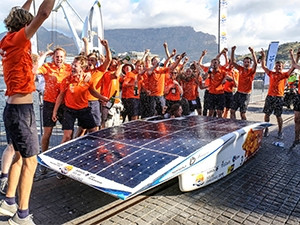
Dutch team Nuon won the Sasol Solar Challenge after completing 4 716km, breaking a four-year-old record of 4 630km and beating Japanese team Tokai by 172km.
Eleven teams from all over the world crossed the finish line after successfully driving just over 27 000km collectively on public roads on solar power alone.
The gruelling challenge takes place over eight days between Pretoria and Cape Town, covering more than 2 000km, with some teams clocking as much as 4 000km on option loops on the routes. The aim is to cover as much distance as possible, powered by the African sun.
The challenge is sponsored by Sasol as a vehicle of inspiration to young South Africans to become the country's future engineers and scientists.
The futuristic solar-powered cars were built by students from all over the world, including teams from South African universities and high schools.
"We're really excited - we already started celebrating in traffic as we came into Cape Town when we suddenly realised that we'd won. The team that is here has been working on the car for years, so they were very emotional," said Sarah Bennink Bolt from the Nuon team.
With new regulations set for the global competition, all the teams will use the South African event to build completely new vehicles for the 2017 challenge in Australia, which is shorter than the Sasol Solar Challenge.
In SA, five teams held their own against the tough international competition. North-West University (NWU) came in fourth position with 3 524km under their belt, and high school team Maragon Olympus managed to beat the University of Johannesburg (UJ) by just 40km.
"We are very proud of the fact that Sirius x25, the NWU solar car, travelled through the whole of South Africa without ever once being put on a trailer," said Jimmy Pressly from the NWU team. "The competition was great, and representing South Africa like this was a privilege. We plan on keeping the flag flying high by competing in the Bridgestone World Solar Challenge in 2017 with a brand new, better car."
NWU had to work hard to come back from an accident during track testing just before the challenge began. But the 28-member team worked long hours, beating two international and four South African teams.
Another achievement in the 2016 Sasol Solar Challenge was celebrated when high school team Maragon Olympus crossed the finish line in seventh place, narrowly beating UJ.
"Beating UJ is an enormous achievement for us as a school. This would not have been possible without the efforts of the whole team," said team manager Marinda Jordaan. "With hard work and a lot of persistence, we pulled it off. What the future holds for us as a school participating again is under discussion, but the Solar Eagle will likely retire to a museum after the 2016 Sasol Solar Challenge."
For the Sasol Solar Challenge, a new record has been set, and teams are already planning their return in 2018.
Sasol Solar Challenge director Winstone Jordaan said this was the most competitive event to date.
"The calibre of competition at this year's challenge has been awe-inspiring to watch. We also had a very safe event with no major incidents - which is always our biggest point of pride when moving more than 350 people through the country on public roads."
Share